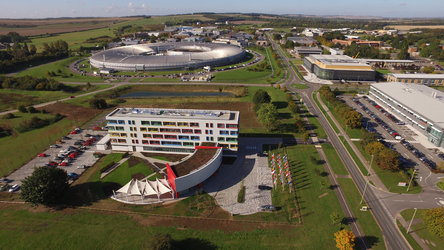Teachers participate in workshop at Harwell
On 25 October, 25 UK teachers were welcomed at Harwell (UK) for a workshop focusing on how satellite application activities can be used in the classroom.
The ‘Teachers Masterclass’ took place in the Satellite Applications Catapult building located near the European Centre for Space Applications and Telecommunications (ECSAT), ESA’s most recent operational site in Europe. Established at the Harwell Science, Innovation and Business Campus in Oxfordshire, ECSAT is growing rapidly. It will support activities related to telecommunications, integrated applications, climate change, technology, and science.
The teachers’ workshop focused on how to bring satellite application activities into the classroom. A presentation about ESA’s Telecommunications and Integrated Applications activities was given to the teachers by Emmanuel Ramos, Senior Advisor for ESA’s Directorate of Telecommunications & Integrated Applications. “Space is a most exciting topic,” he said, “offering teaching examples in nearly all scientific fields. Using space when teaching can help convince young people to pursue their studies in science and engineering, preparing the next generation of skilled labour for our society”.
Space applications are now so widespread in our everyday lives that many people are unaware that space and satellites are involved. “This workshop was all about the novel uses of space data and its applications,” said Anu Ojha, Director of the UK’s National Space Academy, who organised the workshop on ESA's behalf.
The teachers took part in hands-on workshops. One involved simulating the way ocean temperatures are measured from orbit in order to collect environmental data. The experiment simulated the way satellites take readings of the same area during each Earth orbit. Using an infrared thermometer, they took readings across the surface at regular intervals first with cold, and then with warm water. The experiment was then repeated using thermochromic film (which changes colour depending on the temperature), enabling the teachers to see how temperature differences drive ocean currents. The teachers then compared their results to global data on ocean currents obtained from space. A representative from the UK European Space Education Resource Office (ESERO UK) also presented teachers the activities they offer.

Satellite navigation devices can now tell us how long we have to wait for the bus. Farmers use similar devices to track their passage across fields when spreading fertiliser. This allows them to see if they have missed or duplicated areas, making better use of their resources. In some cases, farmers found that it reduced the amount of fertiliser they used, making it more profitable for them.
Satellite applications have a lot of potential. They can improve the operation and safety of land, sea, and air transport, as well as help protect the environment in terms of climate change (by measuring water levels), emergency responses (e.g. by providing an accurate picture of areas affected by flooding), natural resources preservation (e.g. by showing sources of pollution), and sustainable development (e.g. applications in agriculture, tele-education, and telemedicine).
In March 2012, the Satellite Industry Association published a report that estimated that the global revenue from satellites in 2011 alone was $177 billion. Of those 177 billion, 100 came from satellite services. This included telecommunications and the commercial exploitation of satellite data. These figures show that space is now an essential part of the economy, and will also play an increasing role in politics. Because the environmental effects of human behaviour can now be monitored from space, space applications can influence governmental policies and political decision making. The potential market for satellite-based services is estimated to be more than 30 times greater than the costs associated with supporting satellite infrastructure. This implies a significant potential for stimulating economic growth.

Teachers learned how to use, in the classroom, real-time space data from mobile applications. They also learned to make scientific judgements and explore scientific modelling of climatic and environmental events.
“Using space in our classrooms is of critical importance,” said Anu, who goes on to quote one of the NASA Apollo astronauts by saying, “We went all the way to the Moon, but the most important discovery was the Earth.”
Satellite data is now crucial to understanding the Earth, and this workshop helped prepare teachers so that they can better prepare their students for the future. Career prospects in this sector are promising. In Europe, this sector provides direct employment for 35,000 people. One should also consider the direct and indirect employment involved in the applications and services sectors, which may be estimated to be one order of magnitude larger.





